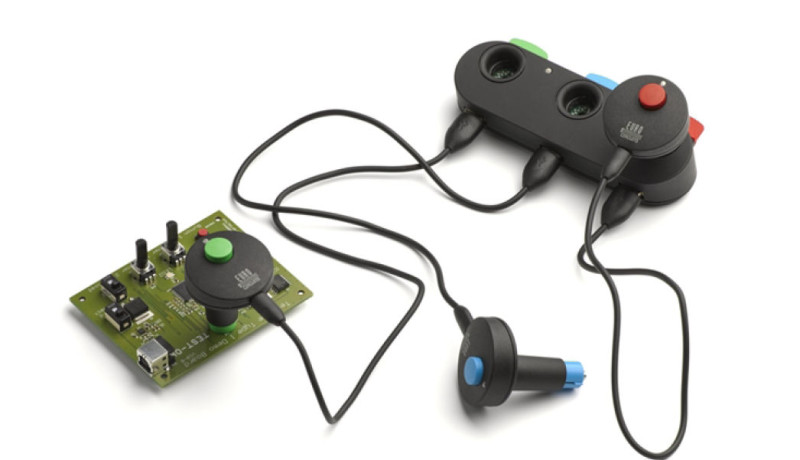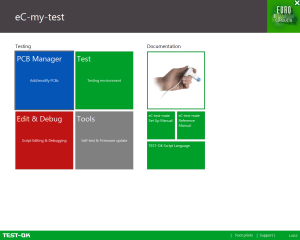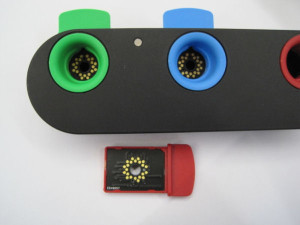Review: eC-test-mate PCB functional tester
November 24, 2016
on
on

The eC-test-mate is a system for performing functional tests on assembled circuits during the manufacturing process. The three different test heads are each specialized for a particular application: the T1 (green) is optimized for general-purpose use and has four analog inputs and outputs, four digital outputs and a UART for serial communications; the T2 (blue) emphasizes communication interfaces and has two analog inputs, four bi-directional digital inputs and outputs, four dedicated digital outputs, CAN, RS485, I2C and UART; the T3 (red) offers additional measuring functions and for this purpose has 8 pins that can function as analog or digital inputs, four analog outputs and a group of seven digital inputs with programmable logic levels.
 The power of the system is that complex tooling becomes unnecessary. No test setups, no connectors, only the PCB footprint for the Test Head is required in order to probe the circuit. Through a script that you write yourself, the system automatically carries out the prescribed tests and reports the results immediately.
The power of the system is that complex tooling becomes unnecessary. No test setups, no connectors, only the PCB footprint for the Test Head is required in order to probe the circuit. Through a script that you write yourself, the system automatically carries out the prescribed tests and reports the results immediately.
The eC-test-mate system consists of the hardware that includes a Docking Station, three Test Heads and a power supply for the Docking Station, and the control software for a PC – eC-my-test – for executing the test scripts. Each Test Head has, in addition to the 21 test pins that via the ingenious head of the Test Head make direct contact with the PCB of the circuit to be tested, also its own 'key'-pin, so that it can only be connected to its own footprint and there is no opportunity for any mistakes. In this way the eC-test-mate prevents costly mistakes, such as connecting the power supply to the wrong lines. For more comprehensive tests it is certainly possible to use multiple Test Heads simultaneously and combine the results.
 Ergonomics has also been considered: the Test Head clicks into its footprint of the PCB to be tested. So there is no need for awkward positioning or to continue to hold the Test Head while the script is running.
Ergonomics has also been considered: the Test Head clicks into its footprint of the PCB to be tested. So there is no need for awkward positioning or to continue to hold the Test Head while the script is running.
 The eC-test-mate Docking Station offers, in addition to a stand with built-in test functionality and firmware-update options for the three Test Heads, also provides complete galvanic isolation between the PC and the probes. Furthermore, the Docking Station also serves as power supply for the Test Heads and supplies up to 7 W or 1 A to the circuit under test, depending on which limit is reached first.
The eC-test-mate Docking Station offers, in addition to a stand with built-in test functionality and firmware-update options for the three Test Heads, also provides complete galvanic isolation between the PC and the probes. Furthermore, the Docking Station also serves as power supply for the Test Heads and supplies up to 7 W or 1 A to the circuit under test, depending on which limit is reached first.
Optionally, the Test Heads can also be connected to the USB port of a PC directly, however in that case there is no galvanic isolation and the power supply to the circuit is then limited to 400 mA or 2 W. For a circuit where one Test Head is sufficient this will of course save space on the workbench.
 The eC-test-mate Docking Station functions as the USB hub for the Test Heads and has a small passive circuit board at the bottom of the Test Head holder that you can use to quickly check whether the Test Head is operating properly. The test routines for this are built into the PC application.
The eC-test-mate Docking Station functions as the USB hub for the Test Heads and has a small passive circuit board at the bottom of the Test Head holder that you can use to quickly check whether the Test Head is operating properly. The test routines for this are built into the PC application.
 The power of the system is that complex tooling becomes unnecessary. No test setups, no connectors, only the PCB footprint for the Test Head is required in order to probe the circuit. Through a script that you write yourself, the system automatically carries out the prescribed tests and reports the results immediately.
The power of the system is that complex tooling becomes unnecessary. No test setups, no connectors, only the PCB footprint for the Test Head is required in order to probe the circuit. Through a script that you write yourself, the system automatically carries out the prescribed tests and reports the results immediately.The eC-test-mate system consists of the hardware that includes a Docking Station, three Test Heads and a power supply for the Docking Station, and the control software for a PC – eC-my-test – for executing the test scripts. Each Test Head has, in addition to the 21 test pins that via the ingenious head of the Test Head make direct contact with the PCB of the circuit to be tested, also its own 'key'-pin, so that it can only be connected to its own footprint and there is no opportunity for any mistakes. In this way the eC-test-mate prevents costly mistakes, such as connecting the power supply to the wrong lines. For more comprehensive tests it is certainly possible to use multiple Test Heads simultaneously and combine the results.
 Ergonomics has also been considered: the Test Head clicks into its footprint of the PCB to be tested. So there is no need for awkward positioning or to continue to hold the Test Head while the script is running.
Ergonomics has also been considered: the Test Head clicks into its footprint of the PCB to be tested. So there is no need for awkward positioning or to continue to hold the Test Head while the script is running.eC-test-mate Docking Station
 The eC-test-mate Docking Station offers, in addition to a stand with built-in test functionality and firmware-update options for the three Test Heads, also provides complete galvanic isolation between the PC and the probes. Furthermore, the Docking Station also serves as power supply for the Test Heads and supplies up to 7 W or 1 A to the circuit under test, depending on which limit is reached first.
The eC-test-mate Docking Station offers, in addition to a stand with built-in test functionality and firmware-update options for the three Test Heads, also provides complete galvanic isolation between the PC and the probes. Furthermore, the Docking Station also serves as power supply for the Test Heads and supplies up to 7 W or 1 A to the circuit under test, depending on which limit is reached first.Optionally, the Test Heads can also be connected to the USB port of a PC directly, however in that case there is no galvanic isolation and the power supply to the circuit is then limited to 400 mA or 2 W. For a circuit where one Test Head is sufficient this will of course save space on the workbench.
 The eC-test-mate Docking Station functions as the USB hub for the Test Heads and has a small passive circuit board at the bottom of the Test Head holder that you can use to quickly check whether the Test Head is operating properly. The test routines for this are built into the PC application.
The eC-test-mate Docking Station functions as the USB hub for the Test Heads and has a small passive circuit board at the bottom of the Test Head holder that you can use to quickly check whether the Test Head is operating properly. The test routines for this are built into the PC application.Read full article
Hide full article



Discussion (0 comments)